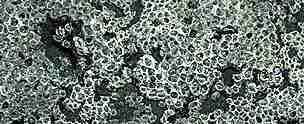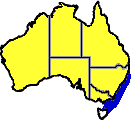|
|

Honeycomb Barnacle Chamaesipho tasmanica
Form:

The Honeycomb barnacle is a small barnacle with four main non-porous shell plates.
They often occur together in vast numbers, and may be so crowded together that it is difficult to distinguish separate plates.
The opercular valve edges (on top) form a regular cross.
Colour:
If uneroded, mostly grey to white in colour, becoming brownish in more eroded specimens.
Phylum: |
Arthropoda |
Author: |
Spengler, 1790 |
Family: |
Chthamalidae |
Size: |
5-8 mm wide, 5-19 mm high |
Distribution:
 Found
only in south-eastern Australia. From New South Wales to Tasmania, and
New Zealand
Found
only in south-eastern Australia. From New South Wales to Tasmania, and
New Zealand
Habitat:
Occurs on exposed rock surfaces on the open coast in the middle to upper intertidal areas.
Found only on rocks and never on wood. Never found in estuaries.
Biology:
The Honeycomb Barnacle is by far the most numerous of the barnacle species, and may cover large areas of rock surface so that nothing but barnacles may be seen.
Usually small. In some areas of the rugged western Victorian coast, individuals may be up to 25 mm tall. Elsewhere, they are the smallest barnacle on rocky shores.
Questions:
Why might these barnacles occur together in vast numbers?
These barnacles live very high on the shore, at mid- to high-tide level. What limitations does this place on individuals of this species ?
References:
This species is called Chamaesipho columna in most other reference books.
Bennett, I. (1987) W.J. Dakin's classic study: Australian Seashore, p. 244, Angus & Robertson.
Davey, K. (1998) A Photographic Guide to Seashore Life of Australia, p. 42 New Holland.
Edgar, G.J. (1998) Australian Marine Marine Life: the plants and animals of temperate waters, p. 172, Reed.
Jones, D. & Morgan, G, (1994) A field guide to Crustaceans of Australian Waters, p. 34, Reed.
Marine Research Group of Victoria (1984) Coastal Invertebrates of Victoria: an atlas of selected species. p. 105, Museum of Victoria.
Surf
Barnacle
Six-plated Barnacle
Honeycomb Barnacle
Rose-coloured Barnacle
Rosette Barnacle
Giant Rock Barnacle
Home
Page
Taxonomy
Biogeography
Rocky Shores
Tidal Levels
Intertidal Zonation
Environmental Factors
Biological
Factors
Feeding Relationships
Activities
Glossary
References
 Life
on Australian Seashores
Life
on Australian Seashores
by Keith Davey (C) 2000
Learning Consultant
- Media
The University of Newcastle
email at australian_seashores@hotmail.com
Scientific Consultant: Phil
Colman
site created 01.01.98 : updated 01.04.2000